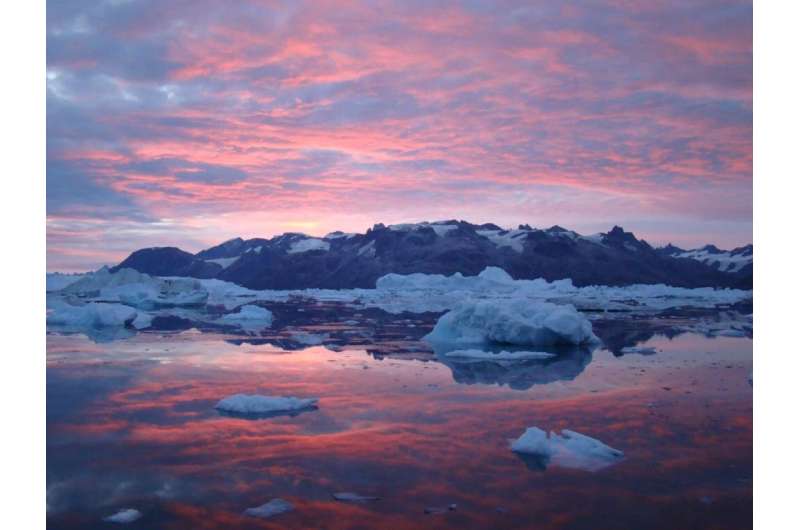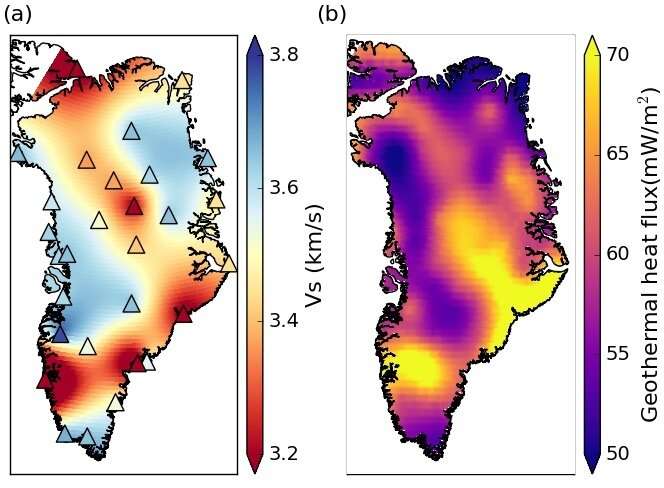The noise created by the Earth’s movements has been used to build up a detailed picture of the geological conditions beneath the Greenland Ice Sheet and the impact on ice flow, described in new research led by Swansea University.
The team studied Rayleigh waves—seismic waves generated by movements such as earthquakes—to produce high-resolution images of the rocks underneath the ice sheet, helping to identify which areas are most susceptible to faster ice flow.
The Greenland Ice Sheet is the second largest reservoir of freshwater on Earth. However, the rate of loss of ice mass from the ice sheet has increased six-fold since 1991, which accounts for around 10% of the recent rise in global sea levels.
The geological conditions in the ground beneath an ice sheet or glacier play a key role in determining ice flow. Key factors include: The makeup of the layers of rock; the temperature of the earth’s crust beneath; and the amount of water present in liquid form between rock and ice as this acts as a lubricant, causing so-called “basal slip” and speeding up the flow of ice.
The problem, however, is how to assess what is happening deep underground, given the remoteness of Greenland and the fact that the ground is covered with ice approximately 2.5 kilometers thick.
In 2009, a permanent network of seismic monitoring stations was installed across Greenland, and they have been used in previous research. However, these studies have offered limited insight on the geological controls on the ice sheet.
This is where the new research comes in. The team was able to map out what is happening down as far as 5 kilometers by measuring Rayleigh waves extracted from the Earth’s noise. These seismic waves travel along the Earth’s surface and are sensitive to variations in Earth’s properties.
By measuring the speed, shape and duration of the waves, researchers are able to work out what material they are traveling through: The mechanical properties of the rocks, such as rigidity and density; the layering of the rocks and the physical properties of the surface soil.

A Greenland Fjord: The noise of the earth’s movements up to 5 km beneath the Greenland ice sheet has been used to build up a detailed picture of the geological conditions and the impact on ice flow and melt, in new research led by Swansea University. © Tavi Murray/Swansea University
Rayleigh waves travel in an elliptical pattern and the specific feature that the researchers assessed was the horizontal to vertical ratio of particle motion within the waves.
They found:
Regions of high geothermal heat concurrent with the proposed historical location of the Iceland hotspot track Soft sedimentary substrates beneath major fast flowing outlet glaciers, revealed by lower wave speeds Some outlet glaciers are particularly susceptible to basal slip, including Jakobshavn, Helheim and Kangerdlussuaq Geothermal warming and softening of basal ice may affect the onset of faster ice flow at Petermann Glacier and the Northeast Greenland Ice Stream.
Dr. Glenn Jones of Swansea University, who led the research as part of his Ser Cymru II Research Fellowship, said, “This research highlights the importance of the coupling between the solid earth and ice sheet dynamics. Interactions with the solid earth control the past, present and future dynamics of the Greenland Ice Sheet.
“Our technique using the elliptical shape of Rayleigh waves means we can build up a more detailed picture than before of the structure of the upper 5 km beneath the ice sheet.
“It will give us a better understanding of the processes that contribute to accelerated ice discharge into the ocean and the consequent sea level rise.”
As well as Swansea University glaciologists, the research team included experts from University College London, the University of Lisbon, the University of Tasmania, GeoSciences Barcelona, and Istituto Nazionale di Geofisica e Vulcanologuia in Bologna.
More information:
G. A. Jones et al, Uppermost crustal structure regulates the flow of the Greenland Ice Sheet, Nature Communications (2021). DOI: 10.1038/s41467-021-27537-5
Provided by
Swansea University
Citation:
Using the Earth’s noise to see beneath the Greenland ice sheet (2021, December 15)
